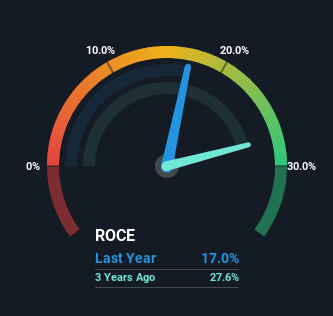- United States
- /
- Specialty Stores
- /
- NasdaqCM:TKLF
Tokyo Lifestyle (NASDAQ:TKLF) May Have Issues Allocating Its Capital
If you're not sure where to start when looking for the next multi-bagger, there are a few key trends you should keep an eye out for. Typically, we'll want to notice a trend of growing return on capital employed (ROCE) and alongside that, an expanding base of capital employed. Basically this means that a company has profitable initiatives that it can continue to reinvest in, which is a trait of a compounding machine. Having said that, from a first glance at Tokyo Lifestyle (NASDAQ:TKLF) we aren't jumping out of our chairs at how returns are trending, but let's have a deeper look.
What Is Return On Capital Employed (ROCE)?
Just to clarify if you're unsure, ROCE is a metric for evaluating how much pre-tax income (in percentage terms) a company earns on the capital invested in its business. Analysts use this formula to calculate it for Tokyo Lifestyle:
Return on Capital Employed = Earnings Before Interest and Tax (EBIT) ÷ (Total Assets - Current Liabilities)
0.17 = US$8.7m ÷ (US$159m - US$108m) (Based on the trailing twelve months to September 2024).
Therefore, Tokyo Lifestyle has an ROCE of 17%. On its own, that's a standard return, however it's much better than the 13% generated by the Specialty Retail industry.
Check out our latest analysis for Tokyo Lifestyle

Historical performance is a great place to start when researching a stock so above you can see the gauge for Tokyo Lifestyle's ROCE against it's prior returns. If you want to delve into the historical earnings , check out these free graphs detailing revenue and cash flow performance of Tokyo Lifestyle.
The Trend Of ROCE
Unfortunately, the trend isn't great with ROCE falling from 38% five years ago, while capital employed has grown 134%. Usually this isn't ideal, but given Tokyo Lifestyle conducted a capital raising before their most recent earnings announcement, that would've likely contributed, at least partially, to the increased capital employed figure. The funds raised likely haven't been put to work yet so it's worth watching what happens in the future with Tokyo Lifestyle's earnings and if they change as a result from the capital raise.
On a side note, Tokyo Lifestyle's current liabilities are still rather high at 68% of total assets. This can bring about some risks because the company is basically operating with a rather large reliance on its suppliers or other sorts of short-term creditors. While it's not necessarily a bad thing, it can be beneficial if this ratio is lower.
In Conclusion...
Even though returns on capital have fallen in the short term, we find it promising that revenue and capital employed have both increased for Tokyo Lifestyle. However, despite the promising trends, the stock has fallen 62% over the last year, so there might be an opportunity here for astute investors. So we think it'd be worthwhile to look further into this stock given the trends look encouraging.
One more thing: We've identified 5 warning signs with Tokyo Lifestyle (at least 2 which don't sit too well with us) , and understanding these would certainly be useful.
While Tokyo Lifestyle may not currently earn the highest returns, we've compiled a list of companies that currently earn more than 25% return on equity. Check out this free list here.
Valuation is complex, but we're here to simplify it.
Discover if Tokyo Lifestyle might be undervalued or overvalued with our detailed analysis, featuring fair value estimates, potential risks, dividends, insider trades, and its financial condition.
Access Free AnalysisHave feedback on this article? Concerned about the content? Get in touch with us directly. Alternatively, email editorial-team (at) simplywallst.com.
This article by Simply Wall St is general in nature. We provide commentary based on historical data and analyst forecasts only using an unbiased methodology and our articles are not intended to be financial advice. It does not constitute a recommendation to buy or sell any stock, and does not take account of your objectives, or your financial situation. We aim to bring you long-term focused analysis driven by fundamental data. Note that our analysis may not factor in the latest price-sensitive company announcements or qualitative material. Simply Wall St has no position in any stocks mentioned.
About NasdaqCM:TKLF
Tokyo Lifestyle
Engages in the retail and wholesale of beauty, health, sundry, and other products in Japan, China, Hong Kong, the United States, Canada, Thailand, and the United Kingdom.
Adequate balance sheet with low risk.
Similar Companies
Market Insights
Community Narratives



